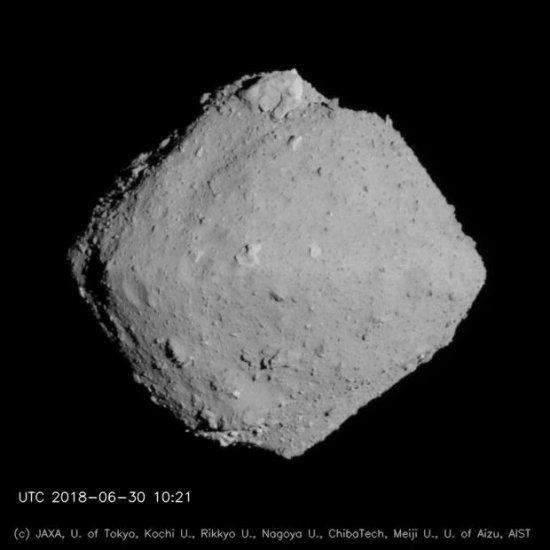
Samples from the asteroid Ryugu contain key ingredients in the biological cookbook.
There are a lot of reasons the early Earth was a biologically barren place. For one thing, its surface was molten; for another thing, it had no survivable atmosphere, with very little of the molecular oxygen that is essential for biology. Then too, Earth simply lacked the chemistry to produce biology. The human body, to take just one life form, is made up of 60 different chemical elements. That’s despite four of them—oxygen, carbon, hydrogen, and nitrogen—representing 96.2% of the total. That’s a long recipe list, and our planet was short on many of those key ingredients.
[time-brightcove not-tgx=”true”]Astronomers and biologists have long believed that a lot of the chemistry necessary for life was imported to Earth aboard incoming asteroids and comets, providing what one group of researchers called a prebiotic feedstock. Now, a new study in Nature Astronomy, based on analysis of microscopic grains of the asteroid Ryugu, brought back to Earth by Japan’s Hayabusa 2 spacecraft in 2020, provides more evidence that our primitive planet indeed had to depend on cosmic deliveries before it could begin cooking up life. What’s more, the chemistry of Ryugu shows that those ingredients had to have originated not in near-Earth space, but far out in the solar system before they could make their way to us.
Ryugu is a 0.55 mile-long rock traveling around the sun in an orbit similar to Earth’s. It is a so-called C-type asteroid, a species of space rubble that is heavy in carbon and represents about 75% of all known asteroids. Hayabusa 2 was launched on Dec. 3, 2014 and landed on Ryugu on Feb. 22, 2019, where it gathered up a precious 5.4 gm (0.19 oz.) of material from two sites—one on the surface of the asteroid and one in the ejected material surrounding a crater; the latter sample could provide clues to the make-up of the asteroid’s interior.
The spaceship traveled 3.2 billion miles round-trip to collect and deliver its sample, and once the little pinch of Ryugu was returned to Earth, it was transferred to the Japanese space agency’s Institute of Space and Astronautical Science, where a handful of lucky scientists had a chance to study it. Among them were members of a team from the Institut d’Astrophysique Spatiale (IAS)—an astrophysics center near Paris—who designed and built a highly miniaturized infrared spectral microscope to provide a first characterization of the mineralogical and molecular composition of the Ryugu grains.
The IAS team, along with other colleagues from France, as well as Japan and the U.K., were looking not only for organic elements and compounds in the sample, but specifically elements and compounds in their hydrated form—that is, with water molecules in the mix. Finding those forms would establish that the grains originated in deep space—out beyond what is known as the snow line. In the inner solar system—this side of Jupiter—the proximity of the sun causes both free-floating water and water entrained on bodies like asteroids to flash into vapor. Outside of that limit, water survives as ice, allowing it to combine with other materials found on asteroids.
The spectral microscope that the IAS scientists built included a small, sealed chamber in which the bit of asteroid grit was placed; the chamber was pumped free of earthly atmosphere to prevent contamination that would yield misleading results. The grains in the sample were no bigger than a few hundred microns—or millionths of a meter—and were handled in small dishes made of sapphire, to allow the sample to be studied in wavelengths beyond the visible and up into the infrared.
“Sapphire can be cut pure and is transparent in the infrared,” says Jean-Pierre Bibring, professor of astrophysics at the IAS. A tiny mirror was positioned beneath the grains to reflect away errant light, but the mirror was made of polished gold, not glass. “We want a mirror that does not produce any potential contamination,” Bibring says. “We made it of gold because we know how to make a very flat, very pure gold surface.”
The high-tech hardware paid big dividends. Using X-ray spectrometry, infrared hyperspectral imagery and more, the researchers discovered that the sample was made up of hydrated (or water-containing) ammonium, magnesium, and phosphorus, which they dubbed “HAMP” grains. The presence of the water molecules provided new evidence that the grains indeed formed deep in space, beyond the snow line. While all of the ingredients in the HAMP grains are essential to life, the ammonium is a particularly versatile entry in the biological cookbook, since its molecule is NH3, contributing both nitrogen and hydrogen when it breaks down. The HAMP grains in the Ryugu sample were also very soluble, meaning that once an asteroid carrying them entered the atmosphere and crashed on Earth, they would dissolve into the first standing water they found.
There were other clues that rocks like Ryugu served as ancient delivery trucks for biological chemicals. The ratio of phosphorus to carbon—the P/C ratio—in Ryugu samples is about 1 to 100. That, as it happens, is precisely what the P/C ratio is in the earthly biomass, suggesting—though not confirming—that the carbon chemistry of such asteroids helped shape the chemistry of our planet.
Of course, most asteroids are tiny compared to the 8,000-mile diameter Earth. Even during the solar system’s shooting-gallery phase, about four billion years ago, when accreted rubble was pounding the inner planets—the amount of material that fell to Earth was comparatively tiny. But it didn’t have to be too much to get biology started. Life, given a chance, blooms, grows, and explodes. It’s true of a single organism, and it was true of our planet too.
“You don’t have to have a huge amount of material,” says Bibring. “If you start life, it will necessarily spread in the direction the context initiates. It’s the Darwinian process.”